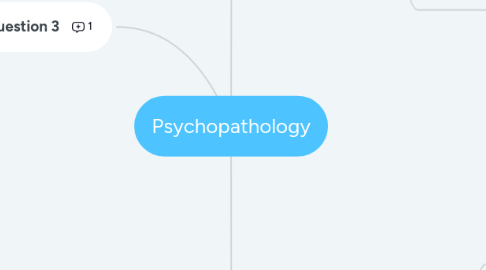
1. Question 3
1.1. Intro
1.1.1. What is Schitsophrenia?
1.1.1.1. "AN INDIVIDUAL THAT IS IN THEIR OWN REALITY IN COMPARISONS TO THE REALITY OF OTHERS"
1.1.2. Clinical characteristics and diagnosis
1.2. Genetics
1.2.1. Twin studies/adoption studies
1.2.1.1. enlarged ventricles
1.2.1.2. neurons in disarray
1.2.1.3. unlikely to be a single gene
1.2.1.4. possibly the addition of life events
1.3. Dopamine Hypothesis
1.3.1. Exessive levels of dopamine in the brain
1.3.2. higher amount of dopamine receptors in Basal Ganglia
1.3.3. Hypersensitivy of neurons to dopamine
1.3.4. complex relationships between SEROTONIN/DOPAMINE & GABA
1.3.5. Medication in order to lower levels of dopamine absorption/productions/sensitivity takes time for the effects to work
1.4. Developmental
1.4.1. Neurodevelopmental and Viral theory
1.4.1.1. Changes in the brain during foetal development
1.4.1.2. viral theory/ differences in executive functioning in EEG's & fMRI's
1.4.1.3. Abnormal pathways between Limbic System & Prefrontal cortex
1.5. Cognitive
1.5.1. Frith's Model
1.5.1.1. Conscious and preconscious processing of an inner voice
1.5.1.2. Breaking the filter between the conscious and unconscious voice
1.5.1.3. people CAN live with their voices so it isn't as much of a bad thing as is perceived
1.6. Family
1.6.1. Family mechanisms are unlikely to be the cause but more the maintenance
1.6.2. Family therapy is found to be useful in treatment
1.7. Conclusion
1.7.1. the disorder itself is a complex one, and with several causes.
1.7.2. you can have schizophrenia wit the absence of relatives or biological factors, as the factors are not dependent on genetics.
1.7.3. Pre or post birth trauma
1.7.3.1. What happens to the brain during adolescence
1.7.3.2. Cerebral pruning during development coincide with the appearance of schitsophrenia
1.7.4. wrongly diagnosed bipolar, and medication to treat the manic episodes can issue schizophrenia
2. Question 1
2.1. Intro
2.1.1. Why do we diagnose?
2.1.2. What is the purpose?
2.1.3. what methods are there (DSM/ICD)
2.1.4. Many problems are associated with the 'diagnostic' process.. state which ones you will mention here.
2.2. Diagnosis
2.2.1. Problems with diagnostic process
2.2.1.1. Rosenhan 1973
2.2.1.1.1. Type 1&2 errors
2.2.1.1.2. If an individual presents symptoms, it is the clinicians job to diagnose - no questionable doubt.
2.2.2. Development and additions towards DSM
2.2.2.1. adaptations made between DSM 4 and 5 due to the research being conducted and updating knowledge
2.2.3. interpretation of individuals symptoms
2.2.4. social norms influencing patient
2.2.5. Sick/Expert role
2.3. Treatment
2.3.1. medicinal
2.3.1.1. "a pill for all ills"
2.3.1.2. Some take a long time to work
2.3.1.3. get worse before they get better
2.3.1.4. possible intolerance?
2.3.2. CBT
2.3.2.1. useful for some disorders more than others
2.3.3. The kappa method with DSM-V
2.3.3.1. differences between diagnoses of various disorders
2.3.3.1.1. Biases /Reliability
2.3.3.1.2. professionals who have used the DSM's are reluctant to move on from one edition to another, due to the complex format changes, e.g. DSM4->DSM5
2.4. Conclusion
2.4.1. We need SOMETHING albeit subjective, and has some flaws but at least the DSM and ICD updates themselves with empirical research findings and have a helpful idea for appropriate treatment
2.4.2. Drugs are available on the NHS, whereas there are waiting lists for CBT etc.
3. Question 2
3.1. Intro
3.1.1. what are mood disorders
3.1.2. what is the mood disorder you are going to discuss?
3.1.2.1. Major Depressive Disorder (MDD)
3.1.3. Aetiologies/Treatments to be discussed/used
3.2. Bio
3.2.1. Bio Explanations
3.2.1.1. Neurotransmitters
3.2.1.1.1. serotonin (short allell) transporter gene, dopamine
3.2.1.1.2. chronic stress and depression
3.2.2. Bio Treatments
3.2.2.1. Medication
3.2.2.1.1. SSRI's
3.2.2.1.2. MAO's
3.3. Cog
3.3.1. Cog/Env Explanations
3.3.1.1. Cognitive Triad
3.3.1.2. ABC model
3.3.1.3. Innacurate beliefs
3.3.1.4. catastrophizing
3.3.2. Cog Treatments
3.3.2.1. Mindfullness based
3.3.2.2. CBT
3.3.2.3. MBCT
3.3.2.4. REBT
3.3.2.5. The cognitive triad
3.4. Early stress, serotonin gene and later life stressors
3.4.1. Diathesis stress theory
3.4.2. biological Pre-disposition
3.4.3. Early trauma
3.4.4. Later life events
3.5. Conclusion
3.5.1. Combination is better, there is no way you can just use the biological or cognitive explanation independently and respectively
3.5.2. Loos for a cause/trigger
3.5.3. empowers the individual to have insight and change their own perceptions/cognitions/coping strategies etc.

